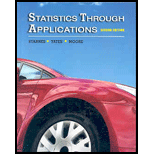
Concept explainers
a)
To identify whether the observational study or experimental study.
a)
Answer to Problem 1.42RE
This is an experimental study.
Explanation of Solution
Given:
Do external rewards—things like money, praise, fame, and grades—promote creativity? Not according to the study in Exercise 1.35 (page 28). Children who competed for prizes generally produced less creative collages than children who simply shared their artwork. Will similar results hold for college students? The psychologist of Exercise 1.35 designed another study—this time involving 47 experienced creative writers who were college students. Students were divided into two groups using a chance process (like drawing names from a hat). The students in one group were given a list of statements about external reasons for writing, like public recognition, making money, or pleasing their parents. Students in the other group were given a list of statements about internal reasons for writing, such as expressing yourself and enjoying working with words. Both groups were then instructed to write a poem about laughter. Each student's poem was rated separately by 12 different poets using a creativity scale?'
First need to understand about the experimental study and observational study:
Experimental study: Assigning people or things to groups and applying some treatment to one group, while the other group does not receive the treatment.
Observation study: In an observational study, measure or survey members of a sample without trying to affect them.
This study is an experimental study. There are two groups of students. For each group, there was a different information given. Hence, it is experimental study.
b)
To explain why students divided into two groups using chance process.
b)
Answer to Problem 1.42RE
To eliminate the chance of same minded people.
Explanation of Solution
Given:
Do external rewards—things like money, praise, fame, and grades—promote creativity? Not according to the study in Exercise 1.35 (page 28). Children who competed for prizes generally produced less creative collages than children who simply shared their artwork. Will similar results hold for college students? The psychologist of Exercise 1.35 designed another study—this time involving 47 experienced creative writers who were college students. Students were divided into two groups using a chance process (like drawing names from a hat). The students in one group were given a list of statements about external reasons for writing, like public recognition, making money, or pleasing their parents. Students in the other group were given a list of statements about internal reasons for writing, such as expressing yourself and enjoying working with words. Both groups were then instructed to write a poem about laughter. Each student's poem was rated separately by 12 different poets using a creativity scale?'
To eliminate a bias in the process, chance process is useful. There is a chance that same minded students can be in one group. Hence, to eliminate the probability of this situation, chance process is selected.
c)
To explain why it is important that none of the poets was aware of which students were in which group
c)
Answer to Problem 1.42RE
To avoid the chance of bias.
Explanation of Solution
Given:
Do external rewards—things like money, praise, fame, and grades—promote creativity? Not according to the study in Exercise 1.35 (page 28). Children who competed for prizes generally produced less creative collages than children who simply shared their artwork. Will similar results hold for college students? The psychologist of Exercise 1.35 designed another study—this time involving 47 experienced creative writers who were college students. Students were divided into two groups using a chance process (like drawing names from a hat). The students in one group were given a list of statements about external reasons for writing, like public recognition, making money, or pleasing their parents. Students in the other group were given a list of statements about internal reasons for writing, such as expressing yourself and enjoying working with words. Both groups were then instructed to write a poem about laughter. Each student's poem was rated separately by 12 different poets using a creativity scale?'
If some poet knows about the previous work or knowledge of any students then there will be a chance of bias. To avoid this biasness, it is important that none of the poets was aware of which students were in which group.
Chapter 1 Solutions
Statistics Through Applications
Additional Math Textbook Solutions
Elementary Statistics
Introductory Statistics (2nd Edition)
Elementary Statistics: Picturing the World (7th Edition)
Introductory Statistics
 MATLAB: An Introduction with ApplicationsStatisticsISBN:9781119256830Author:Amos GilatPublisher:John Wiley & Sons Inc
MATLAB: An Introduction with ApplicationsStatisticsISBN:9781119256830Author:Amos GilatPublisher:John Wiley & Sons Inc Probability and Statistics for Engineering and th...StatisticsISBN:9781305251809Author:Jay L. DevorePublisher:Cengage Learning
Probability and Statistics for Engineering and th...StatisticsISBN:9781305251809Author:Jay L. DevorePublisher:Cengage Learning Statistics for The Behavioral Sciences (MindTap C...StatisticsISBN:9781305504912Author:Frederick J Gravetter, Larry B. WallnauPublisher:Cengage Learning
Statistics for The Behavioral Sciences (MindTap C...StatisticsISBN:9781305504912Author:Frederick J Gravetter, Larry B. WallnauPublisher:Cengage Learning Elementary Statistics: Picturing the World (7th E...StatisticsISBN:9780134683416Author:Ron Larson, Betsy FarberPublisher:PEARSON
Elementary Statistics: Picturing the World (7th E...StatisticsISBN:9780134683416Author:Ron Larson, Betsy FarberPublisher:PEARSON The Basic Practice of StatisticsStatisticsISBN:9781319042578Author:David S. Moore, William I. Notz, Michael A. FlignerPublisher:W. H. Freeman
The Basic Practice of StatisticsStatisticsISBN:9781319042578Author:David S. Moore, William I. Notz, Michael A. FlignerPublisher:W. H. Freeman Introduction to the Practice of StatisticsStatisticsISBN:9781319013387Author:David S. Moore, George P. McCabe, Bruce A. CraigPublisher:W. H. Freeman
Introduction to the Practice of StatisticsStatisticsISBN:9781319013387Author:David S. Moore, George P. McCabe, Bruce A. CraigPublisher:W. H. Freeman





